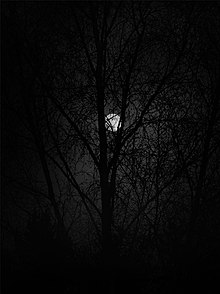Midnight

Midnight is the transition time period from one day to the next: the moment when the date changes. In ancient Roman timekeeping, midnight was halfway between sunset and sunrise (i.e., solar midnight), varying according to the seasons. By clock time, midnight is the opposite of noon, differing from it by 12 hours.
Solar midnight is the time opposite to solar noon, when the sun is closest to the nadir and the night is equidistant from dusk and dawn. Due to the advent of time zones, which make time identical across a range of meridians, and daylight saving time, it rarely coincides with midnight on a clock. Solar midnight is dependent on longitude and time of the year rather than on a time zone.
In the northern hemisphere, "midnight" had an ancient geographic association with "north" (as did "noon" with "south" – see noon). Modern Polish and Belarusian preserve this association with its word for "midnight" (północ, поўнач – literally "half-night"), which also means "north".
Start and end of day
Midnight marks the beginning and ending of each day in civil time throughout the world. It is the dividing point between one day and another. With 12-hour time notation, authorities recommend avoiding confusion between noon and midnight by using "midnight", "12 midnight", "12 mi", or "12:00 midnight."[1]
In the United States and Canada, digital clocks and computers commonly display 12 a.m. right at midnight. While that phrase may be used practically, it helps to understand that any particular time is actually an instant. The "a.m." shown on clock displays refers to the 12-hour period following the instant of midnight, not to the instant itself, so that, when a clock displays "12:00 a.m.", (the instant of) midnight has already passed and the period before noon of a new day has begun. In other words, 11:59 p.m. shows until midnight; at the instant of midnight, it changes to 12:00. Simultaneously, the p.m. changes to a.m., though, strictly speaking, a.m. does not apply to the instant of midnight which separates p.m. and a.m. In 24-hour time notation, "0:00" and "0:00:00" refer to midnight at the start of a given date. Some styles, such as ISO 8601, allow 24:00 to refer to the end of a day. Noon is 12:00:00.

While computers and digital clocks display "12:00 a.m." and "12:00 p.m.", those notations provide no clear and unambiguous way to distinguish between midnight and noon. Strictly speaking, it is actually incorrect to use "a.m." and "p.m." when referring to noon or midnight (12:00). The abbreviation a.m. stands for ante meridiem or before noon and p.m. stands for post meridiem or after noon. Since noon is neither after noon nor before noon, and midnight can equally be twelve hours before and after noon, neither abbreviation is correct (although the length of the error is determined by the smallest unit of time — 12:00:01 p.m. would be the correct notation for "1 second after noon").
The most common ways to represent these times are to:
- a) use a 24-hour clock (00:00 and 12:00, 24:00)
- b) use "12 noon" or "12 midnight", although unless the person is referring to a general time and not a specific day, "12 midnight" is still ambiguous
- c) specify the time between two successive days or dates (Midnight Saturday/Sunday or Midnight December 14/15)
- d) use "12:01 a.m." or "11:59 p.m.", as is used where the ambiguity can have serious consequences, such as in contracts and insurance policies[1]
The thirtieth edition of the U.S. Government Style Manual (2008) sections 9.54 and 12.9b recommends the use of "12 a.m." for midnight and "12 p.m." for noon.[2][3][nb 1] Some religious calendars continue to begin the day at another time — for example, at sunset in the Hebrew calendar and the Islamic calendar.
See also
Notes
- ^ The 29th edition of the U.S. Government Printing Office Style Manual (2000) section 12.9 recommended the opposite the use of "12 p.m." for midnight and "12 a.m." (formerly "12 m.") for noon.
References
- ^ a b "How to use a.m./p.m. vs. noon/midnight". National Institute of Standards and Technology. February 4, 2010 (created), January 18, 2011 (last updated). Retrieved 2012-09-02.
{{cite web}}: Check date values in:|date=(help) - ^ "U.S. Government Printing Office Style Manual Chapter 9". 2008. Retrieved 2009-06-11.
- ^ "U.S. Government Printing Office Style Manual Chapter 12". 2008. Retrieved 2009-06-11.

